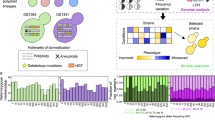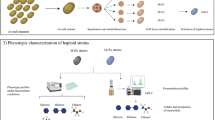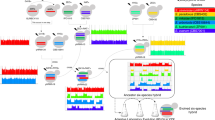Abstract
The multicellular microbial eukaryote Aspergillus nidulans is an excellent model for the study of a wide array of biological processes. Studies in this system contribute significantly to understanding fundamental biological principles and are relevant for biotechnology and industrial applications, as well as human, animal and plant fungal pathogenesis. A. nidulans is easily manipulated using classical and molecular genetics. Here, we describe the storage and handling of A. nidulans and procedures for genetic crossing, progeny analysis and growth testing. These procedures are used for Mendelian analysis of segregation of alleles to show whether a mutant phenotype segregates as a single gene and independent assortment of genes to determine the linkage relationship between genes. Meiotic crossing is used for construction of multiple mutant strains for genetic analysis. Genetic crossing and analysis of progeny can be undertaken in 2–3 weeks and growth testing takes 2–3 days.
This is a preview of subscription content, access via your institution
Access options
Subscribe to this journal
Receive 12 print issues and online access
$259.00 per year
only $21.58 per issue
Buy this article
- Purchase on Springer Link
- Instant access to full article PDF
Prices may be subject to local taxes which are calculated during checkout



Similar content being viewed by others
References
Pontecorvo, G., Roper, J.A., Hemmons, L.M., MacDonald, K.D. & Bufton, A.W.J. The genetics of Aspergillus nidulans . Adv. Genet. 5, 141–238 (1953).
Käfer, E. An 8-chromosome map of Aspergillus nidulans . Adv. Genet. 9, 105–145 (1958).
Käfer, E. The processes of spontaneous recombination in vegetative nuclei of Aspergillus nidulans . Genetics 46, 1581–1609 (1961).
Clutterbuck, A.J. A mutational analysis of conidial development in Aspergillus nidulans . Genetics 63, 317–327 (1969).
Adams, T.H., Boylan, M.T. & Timberlake, W.E. brlA is necessary and sufficient to direct conidiophore development in Aspergillus nidulans . Cell 54, 353–362 (1988).
Mirabito, P.M., Adams, T.H. & Timberlake, W.E. Interactions of three sequentially expressed genes control temporal and spatial specificity in Aspergillus development. Cell 57, 859–868 (1989).
Timberlake, W.E. Molecular genetics of Aspergillus development. Annu. Rev. Genet. 24, 5–36 (1990).
Oakley, B.R. & Morris, N.R. A beta-tubulin mutation in Aspergillus nidulans that blocks microtubule function without blocking assembly. Cell 24, 837–845 (1981).
Osmani, S.A., Engle, D.B., Doonan, J.H. & Morris, N.R. Spindle formation and chromatin condensation in cells blocked at interphase by mutation of a negative cell cycle control gene. Cell 52, 241–251 (1988).
Osmani, S.A., Pu, R.T. & Morris, N.R. Mitotic induction and maintenance by overexpression of a G2-specific gene that encodes a potential protein kinase. Cell 53, 237–244 (1988).
Osmani, S.A. & Mirabito, P.M. The early impact of genetics on our understanding of cell cycle regulation in Aspergillus nidulans . Fungal Genet. Biol. 41, 401–410 (2004).
Xiang, X., Zuo, W., Efimov, V.P. & Morris, N.R. Isolation of a new set of Aspergillus nidulans mutants defective in nuclear migration. Curr. Genet. 35, 626–630 (1999).
Momany, M. Polarity in filamentous fungi: establishment, maintenance and new axes. Curr. Opin. Microbiol. 5, 580–585 (2002).
Goldman, G.H. & Käfer, E. Aspergillus nidulans as a model system to characterize the DNA damage response in eukaryotes. Fungal Genet. Biol. 41, 428–442 (2004).
Brambl, R. & Marzluf, G.A. (eds.) The Mycota. A Comprehensive Treatise on Fungi as Experimental Systems for Basic and Applied Research (Springer-Verlag, Berlin, Heidelberg, 2004).
Yu, J.H. & Keller, N. Regulation of secondary metabolism in filamentous fungi. Annu. Rev. Phytopathol. 43, 437–458 (2005).
Hicks, J.K., Yu, J.H., Keller, N.P. & Adams, T.H. Aspergillus sporulation and mycotoxin production both require inactivation of the FadA G alpha protein-dependent signaling pathway. EMBO J. 16, 4916–4923 (1997).
Arst, H.N. & Penalva, M.A. pH regulation in Aspergillus and parallels with higher eukaryotic regulatory systems. Trends Genet. 19, 224–231 (2003).
Penalva, M.A. & Arst, H.N. Jr . Recent advances in the characterization of ambient pH regulation of gene expression in filamentous fungi and yeasts. Annu. Rev. Microbiol. 58, 425–451 (2004).
Froeliger, E.H. & Carpenter, B.E. NUT1, a major nitrogen regulatory gene in Magnaporthe grisea, is dispensable for pathogenicity. Mol. Gen. Genet. 251, 647–656 (1996).
Tudzynski, B., Homann, V., Feng, B. & Marzluf, G.A. Isolation, characterization and disruption of the areA nitrogen regulatory gene of Gibberella fujikuroi . Mol. Gen. Genet. 261, 106–114 (1999).
Clutterbuck, A.J. Linkage map and locus list. Prog. Ind. Microbiol. 29, 791–824 (1994).
Galagan, J.E. et al. Sequencing of Aspergillus nidulans and comparative analysis with A. fumigatus and A. oryzae . Nature 438, 1105–1115 (2005).
Machida, M. et al. Genome sequencing and analysis of Aspergillus oryzae . Nature 438, 1157–1161 (2005).
Nierman, W.C. et al. Genomic sequence of the pathogenic and allergenic filamentous fungus Aspergillus fumigatus . Nature 438, 1151–1156 (2005).
Pel, H.J. et al. Genome sequencing and analysis of the versatile cell factory Aspergillus niger CBS 513.88. Nat. Biotechnol. 25, 221–231 (2007).
Martinelli, S.D. & Kinghorn, J.R. (eds.) Aspergillus: 50 Years on (Elsevier Science B.V., Amsterdam, 1994).
Todd, R.B., Davis, M.A. & Hynes, M.J. Genetic manipulation of Aspergillus nidulans: heterokaryons and diploids for dominance, complementation and haploidization analyses. Nat. Protocols DOI 10.1038/nprot.2007.113 (2007).
Tilburn, J. et al. Transformation by integration in Aspergillus nidulans . Gene 26, 205–221 (1983).
Hynes, M.J. Transformation of filamentous fungi. Exp. Mycol. 10, 1–8 (1986).
Nayak, T. et al. A versatile and efficient gene-targeting system for Aspergillus nidulans . Genetics 172, 1557–1566 (2006).
Fincham, J.R. Transformation in fungi. Microbiol. Rev. 53, 148–170 (1989).
Oakley, B.R. et al. Cloning, mapping and molecular analysis of the pyrG (orotidine-5′-phosphate decarboxylase) gene of Aspergillus nidulans . Gene 61, 385–399 (1987).
Oakley, C.E., Weil, C.F., Kretz, P.L. & Oakley, B.R. Cloning of the riboB locus of Aspergillus nidulans . Gene 53, 293–298 (1987).
Osmani, A.H., May, G.S. & Osmani, S.A. The extremely conserved pyroA gene of Aspergillus nidulans is required for pyridoxine synthesis and is required indirectly for resistance to photosensitizers. J. Biol. Chem. 274, 23565–23569 (1999).
Durrens, P., Green, P.M., Arst, H.N. Jr & Scazzocchio, C. Heterologous insertion of transforming DNA and generation of new deletions associated with transformation in Aspergillus nidulans . Mol. Gen. Genet. 203, 544–549 (1986).
Upshall, A. Genetic and molecular characterization of argB+ transformants of Aspergillus nidulans . Curr. Genet. 10, 593–599 (1986).
Yelton, M.M., Hamer, J.E. & Timberlake, W.E. Transformation of Aspergillus nidulans by using a trpC plasmid. Proc. Natl. Acad. Sci. USA 81, 1470–1474 (1984).
van Gorcom, R.F., Punt, P.J., Pouwels, P.H. & van den Hondel, C.A. A system for the analysis of expression signals in Aspergillus . Gene 48, 211–217 (1986).
Davis, M.A., Cobbett, C.S. & Hynes, M.J. An amdS-lacZ fusion for studying gene regulation in Aspergillus . Gene 63, 199–212 (1988).
Szewczyk, E. et al. Fusion PCR and gene targeting in Aspergillus nidulans . Nat. Protocols 1, 3111–3120 (2006).
Pachlinger, R., Mitterbauer, R., Adam, G. & Strauss, J. Metabolically independent and accurately adjustable Aspergillus sp. expression system. Appl. Environ. Microbiol. 71, 672–678 (2005).
Zadra, I., Abt, B., Parson, W. & Haas, H. xylP promoter-based expression system and its use for antisense downregulation of the Penicillium chrysogenum nitrogen regulator NRE. Appl. Environ. Microbiol. 66, 4810–4816 (2000).
Hammond, T.M. & Keller, N.P. RNA silencing in Aspergillus nidulans is independent of RNA-dependent RNA polymerases. Genetics 169, 607–617 (2005).
Gems, D., Johnstone, I.L. & Clutterbuck, A.J. An autonomously replicating plasmid transforms Aspergillus nidulans at high frequency. Gene 98, 61–67 (1991).
Osherov, N. & May, G. Conidial germination in Aspergillus nidulans requires RAS signaling and protein synthesis. Genetics 155, 647–656 (2000).
Fisher, R.A. & Yates, F. Statistical Tables for Biological, Agricultural and Medical Research (Oliver and Boyd, Edinburgh, 1938).
Elliott, C.G. The cytology of Aspergillus nidulans . Genet. Res. Camb. 1, 462–476 (1960).
Acknowledgements
We thank Q. Lang for photography and K. Nguygen for technical assistance.
Author information
Authors and Affiliations
Corresponding author
Ethics declarations
Competing interests
The authors declare no competing financial interests.
Rights and permissions
About this article
Cite this article
Todd, R., Davis, M. & Hynes, M. Genetic manipulation of Aspergillus nidulans: meiotic progeny for genetic analysis and strain construction. Nat Protoc 2, 811–821 (2007). https://doi.org/10.1038/nprot.2007.112
Published:
Issue Date:
DOI: https://doi.org/10.1038/nprot.2007.112
This article is cited by
-
Comparative evaluation of antioxidant, antiglycation and α-glucosidase inhibitory potential of some indigenous medicinal Trigonella species
Vegetos (2022)
-
Co-option of an extracellular protease for transcriptional control of nutrient degradation in the fungus Aspergillus nidulans
Communications Biology (2021)
-
The fungal sexual revolution continues: discovery of sexual development in members of the genus Aspergillus and its consequences
Fungal Biology and Biotechnology (2020)
-
Tolerance to alkaline ambient pH in Aspergillus nidulans depends on the activity of ENA proteins
Scientific Reports (2020)
-
Developmental regulators FlbE/D orchestrate the polarity site-to-nucleus dynamics of the fungal bZIP transcription factor FlbB
Cellular and Molecular Life Sciences (2019)
Comments
By submitting a comment you agree to abide by our Terms and Community Guidelines. If you find something abusive or that does not comply with our terms or guidelines please flag it as inappropriate.



